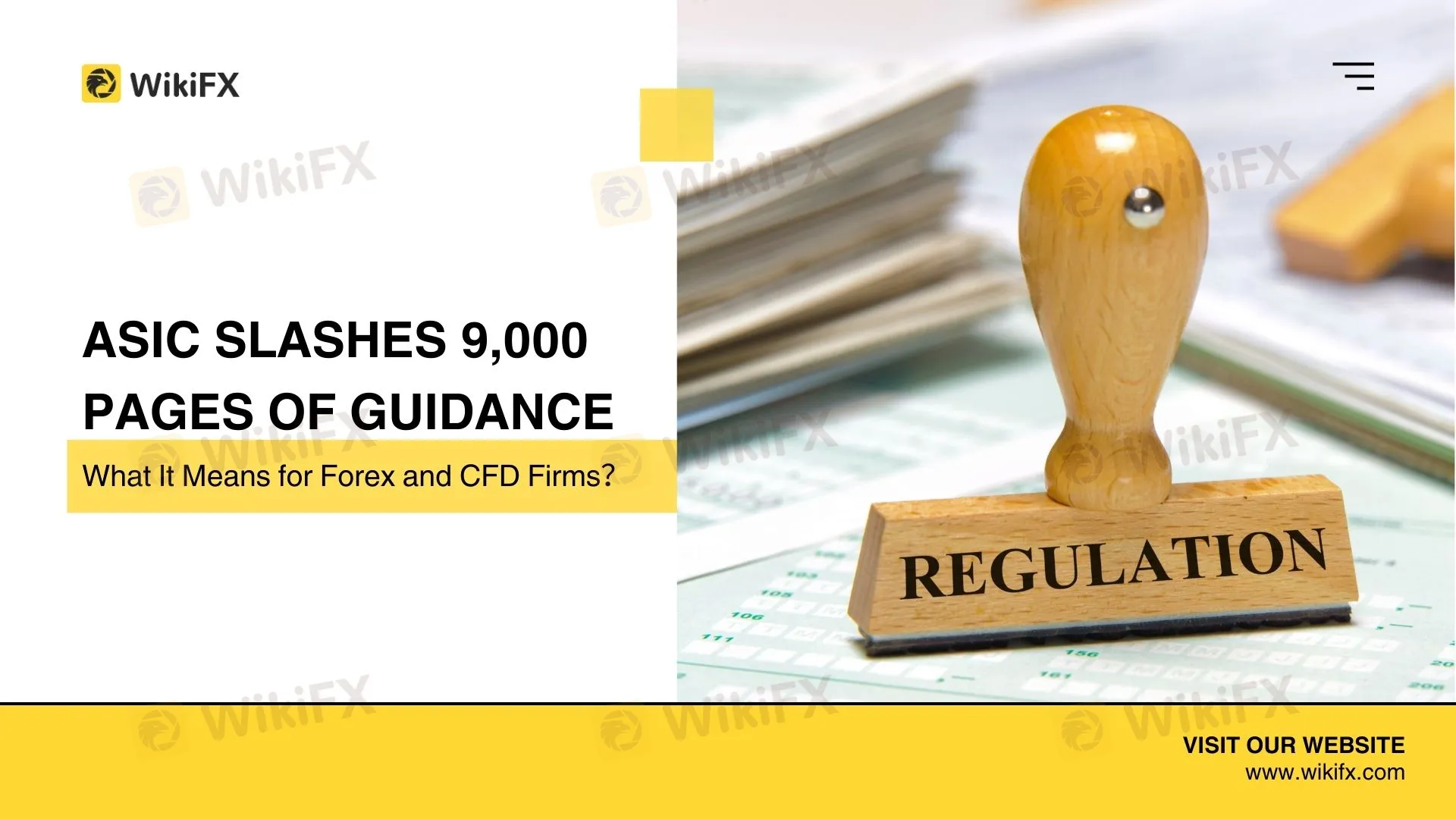简体中文
繁體中文
English
Pусский
日本語
ภาษาไทย
Tiếng Việt
Bahasa Indonesia
Español
हिन्दी
Filippiiniläinen
Français
Deutsch
Português
Türkçe
한국어
العربية
ASIC Slashes 9,000 Pages of Guidance—What It Means for Forex and CFD Firms?
Abstract:ASIC trims 9,240+ pages and pushes digital filings. Discover how these changes impact forex/CFD firms and what actions are now essential.

Australias financial watchdog is cleaning house. In one of its most ambitious moves yet to streamline regulation, the Australian Securities and Investments Commission (ASIC) has eliminated over 9,240 pages of outdated or duplicated guidance. This overhaul is part of a broader shift: fewer legal instruments, digital-first processes, and simpler compliance paths for market participants—including forex and CFD brokers.
Why ASIC Did This—and What Changed
ASICs aim is clear: less clutter, more clarity. For years, financial firms have struggled with a fragmented web of rules, guidance notes, and obscure instruments. Now, ASIC is moving to consolidate its legal toolkit and strip out redundancies.
Key changes include:
- A cleaner, simpler website with “step-by-step” roadmaps tailored for small-business directors and financial advisers.
- Fewer legal instruments, with pilots underway to combine 23 separate documents into fewer, more coherent ones.
- E-signatures and email filings will be accepted starting 1 October, eliminating the need for physical post in many standard filings—roughly 20,000 of them each year.
What This Means for Brokers and Traders
This isn‘t deregulation. It’s simplification with sharper teeth. For forex and CFD firms, the benefits are immediate: less time wasted interpreting outdated guidance, faster processing for product approvals, and fewer grey zones when navigating enforcement risk.
At the same time, ASIC has made clear that streamlined rules wont mean softer scrutiny. The regulator is already using its authority to crack down on misleading digital ads—especially in sectors like forex, crypto, and copy trading.
The Digital Turn: Streamlining, But With Expectations
ASIC processes over 14 million digital transactions a year. Public register searches alone top 299 million annually. With this scale, even small regulatory changes can ripple across the entire financial services ecosystem.
By going digital-by-default, ASIC hopes to cut delays and increase efficiency. But this also raises the bar for internal compliance: brokers must maintain clean records, log all approvals, and archive everything. If it‘s not documented, it didn’t happen.
Not a Loophole—A Warning
Some brokers may view the decluttering as a chance to test boundaries. Thats a mistake. ASIC is increasingly aggressive with non-compliant digital promotions—especially anything resembling “guaranteed profits,” “AI-powered trading,” or cloned offshore sites. Clear rules are easier to enforce, not easier to dodge.
Conclusion
ASIC isn‘t lowering the bar—it’s making the line brighter. Brokers who adjust early will gain in speed, transparency, and resilience. Those who dont will find themselves with less wiggle room than ever.
Disclaimer:
The views in this article only represent the author's personal views, and do not constitute investment advice on this platform. This platform does not guarantee the accuracy, completeness and timeliness of the information in the article, and will not be liable for any loss caused by the use of or reliance on the information in the article.
WikiFX Broker
Latest News
AmariFX Review: Traders Annoyed by Slippage, Login & Withdrawal Issues
Headway Broker Regulation and User Reviews
Vida Markets Regulation and Broker Review
MBFX Review: Withdrawal Denials, Fund Scams & Poor Customer Support Service
Saxo Bank Review 2025: Regulatory Status and Safety Score
FXORO Under the Microscope: Revoked Licenses and The "Advisory" Trap
XXLMARKETS Review: Regulatory Status and Trading Conditions
IUX Review 2025: Regulatory Status and Withdrawal Complaints
The "Broker Group" Abyss: How OmegaPro Trapped Thousands in a Digital Dead End
Libertex Investigation: When "Expert Advice" Leads to Total Ruin
Currency Calculator



